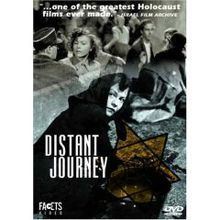Distant Journey
7.4 /10 1 Votes7.4
Director Alfred Radok | 7.2/10 IMDb Duration | |||||||||||||||||||||||||||||||||
 | ||||||||||||||||||||||||||||||||||
Writer Erik Kolar , Mojmir Drvota , Alfred Radok Release date 1949 | ||||||||||||||||||||||||||||||||||
Distant Journey (Czech: Daleká cesta) is a Czech Holocaust film directed by Alfréd Radok and released in March 1949, immediately after World War II. Radok uses experimental cinematography, blending historic footage of the Nazis with a fictional love story between a Jewish woman and her Gentile husband.
Contents

Soon after the film's release, Stalinist censorship was implemented in Czechoslovakia. Radok fled to Sweden and Czech filmmakers began their long struggle against strict communist censors. Film production declined, and Distant Journey was banned from audiences only to reemerge over forty years later.
Distant journey by paul lavender
Summary
Distant Journey follows Hana, a Jewish eye doctor who falls in love and marries a Gentile named Toník. Their simple love story becomes a nightmare when the government begins the systematized extermination of the Jews. Hana's family is transported to Theresienstadt, and the romance becomes a struggle for survival.
Radok never shows blood or lets a gun fire in his story, but the historic footage he integrates into the film achieves a sense of terror. Newsreel footage and clips from Leni Riefenstahl's Triumph of the Will show Adolf Hitler, Joseph Goebbels, and other Nazi leaders reading speeches while a pile of dead nude bodies on the lawn of a concentration camp enforce the atmosphere of the Holocaust. While the historic war-time footage is shown, the previous scene of the feature film is shrunk to the lower right hand corner of the screen, a picture-in-picture effect comparing the wider global conflict to the more immediate effects on the story's central characters.
The slow spread of anti-Semitism that led to the deportation and murder of the Jews is played out in the film. For example, in 1941 Jews were no longer allowed to go to the theater in Prague. Dressed in stunning attire, the happy couple are just about to leave for the theater when they receive this foreboding news from Hana's dejected father. In this way, Radok feeds his audience the history of the war through a personal and easily digested narrative.
The film is full of symbolic cinematography. For example, when a minor character, Professor Reiter, commits suicide, strange camera angles show the old man sitting in his apartment, his open window, the cobblestone street far below, and the stopped hands on a clock. When shrill screams echo from the street and the apartment is empty, the audience is to assume the awful truth.
Cast
Reception
After sitting neglected for over forty years, Distant Journey reemerged in the Czech Republic after the Velvet Revolution for a 1991 television premiere, and was hailed by critics. The Village Voice called it a "masterpiece," comparing it stylistically to Citizen Kane. The film is applauded for both its expressionist cinematography and historical relevance, being one of the first films to confront the Holocaust, only three years after it occurred.
Trivia
Footage from Distant Journey appears in Stanley Kubrick's 1971 film A Clockwork Orange. Kubrick incorporated the shots of children playing amidst rubble into his film.
